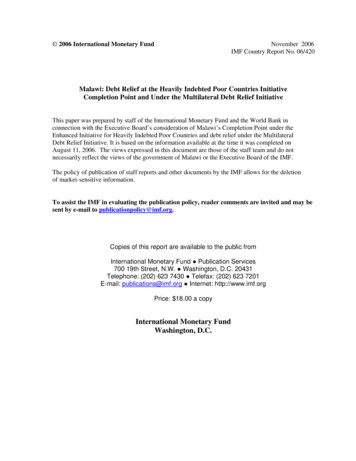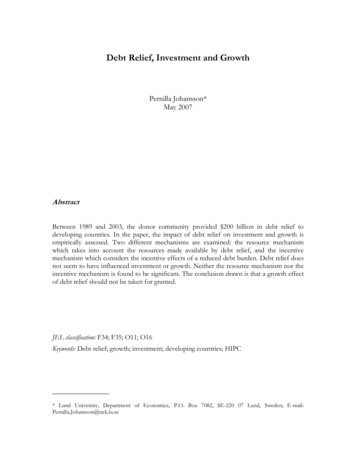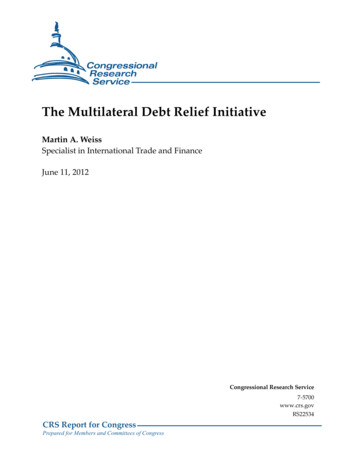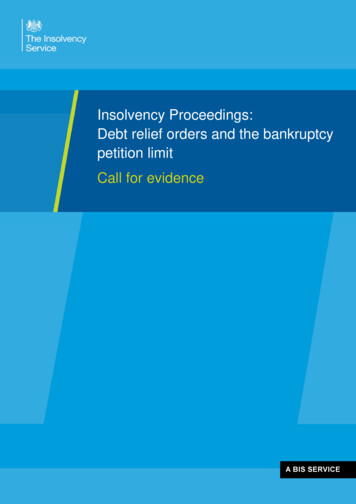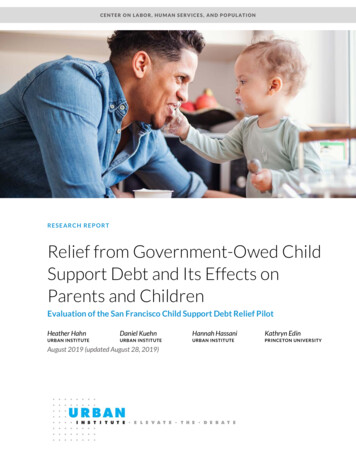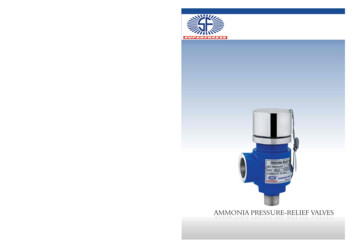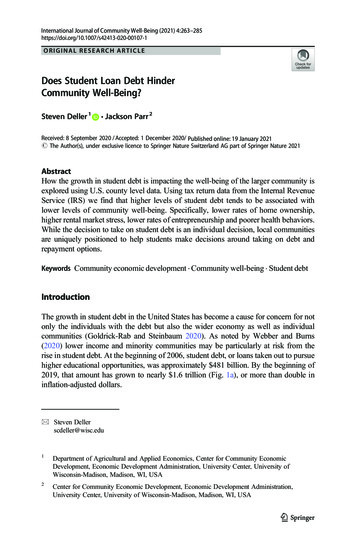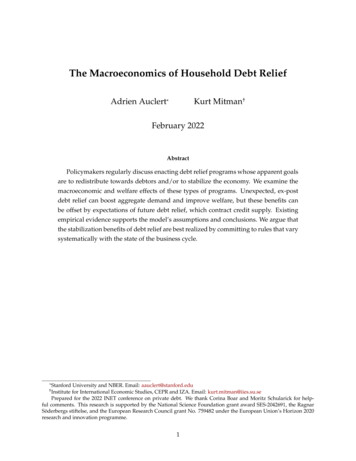
Transcription
OCTOBER 2021THE IIF & DEBT RELIEFHOW THE INSTITUTE OF INTERNATIONAL FINANCELOBBIES TO PREVENT PRIVATE DEBT RELIEF FORDEVELOPING COUNTRIESMyriam Vander Stichele1The IIF & debt relief
ColophonTITLE: The IIF & debt reliefHow the Institute of International Finance lobbies to prevent private debt relief for developing countriesDATE: October 2021AUTHOR: Myriam Vander Stichele, Senior ResearcherCOPY EDITOR: Miles LitvinoffDESIGN: Karen Paalman, wwwgetlos.nlACKNOWLEDGEMENTS: The authors would like to thank the following individuals for the insightsthey provided for this paper: Jasper van Teeffelen (SOMO), Luis Scungio (SOMO) and Iolanda Fresnillo(Eurodad).This publication was made possible with financial support from the Open Society Foundations. Thecontent of this publication is the sole responsibility of SOMO and does not necessarily reflect theviews of the funder.PUBLISHED BY: Stichting Onderzoek Multinationale Ondernemingen (SOMO, Centre for Research onMultinational Corporations)KNSM-laan 171019 LA AmsterdamThe NetherlandsT: 31 (0)20 639 12 91info@somo.nlwww.somo.nlSOMO investigates multinationals. Independent, factual, critical and with a clear goal: a fair andsustainable world, in which public interests outweigh corporate interests. We conduct action orientedresearch to expose the impact and unprecedented power of multinationals. Cooperating withhundreds of organisations around the world, we ensure that our information arrives where it has themost impact: from communities and courtrooms to civil society, media and politicians.2The IIF & debt relief
Table Of ContentsList of abbreviations and terms used4SUMMARY5INTRODUCTION8Context and reasons for this report8Aim of the report and methodology8Overview of the chapters9CHAPTER 1. HOW THE IIF IS ORGANISED TO LOBBY ON DEBT ISSUES101.1 IIF activities – an interlinked strategy101.2. Structure and governance of the IIF131.3 IIF member committees and working groups on debt, G20 debt relief initiatives and related16lobbying1.4 Comments and conclusionsCHAPTER 2. HOW THE IIF ESCAPED THE G20 DEBT RELIEF INITIATIVES (DSSI): THE LOBBYING2123STRATEGIES AND ARGUMENTS2.1 Close relationship between the IIF and G20 in 2020242.2 Analysis of IIF DSSI documents312.3 Comments and conclusions36CHAPTER 3. IIF LOBBYING AND ARGUMENTS ON NEW G20 DEBT RELIEF INITIATIVES383.1 How the IIF lobbied the G20 to promote its members’ interests383.2 Shared responsibility393.3 The IIF lobbies to co-decide on developing and executing the Common Framework393.4 Not committed to the comparability of treatment principle403.5 IIF proposals on how the debt situation needs to be handled403.6 IIF arguments for promoting debt transparency413.7 The argument for “continued market access”433.8 Promoting more debt for financing sustainable development rather than debt relief433.9 Comments and conclusions45CHAPTER 4. THE PRINCIPLES ON STABLE CAPITAL FLOWS AND FAIR DEBT RESTRUCTURING – A47PUBLIC–PRIVATE PARTNERSHIP PROMOTED BY THE IIF4.1 Development and purpose of the Principles for Stable Capital Flows and Fair Debt47Restructuring484.2 Governance of the Principles504.3 The Principles and IIF best practice guidelines on relations between sovereign issuers (debtors)and private creditors4.4 Updating the Principles in 2021564.5 Comments and conclusions on the Principles and the IIF guidance documents57FINAL CONCLUSIONS59RECOMMENDATIONS61Annex I: IIF evaluation criteria for investor relations programmes and data dissemination63Annex II: Reviewing the Contractual Framework for Debt Restructuring (CACs) as summarised by the66annual report on the Principles (2020)3The IIF & debt relief
List of abbreviations and terms used4B20: Business 20, the G20 official engagementEuropean Union to discuss and agree on financial,group from businesseconomic and other global affairsBond: a unit of debt issued by governments,G20 finance track: refers to all the G20 finance-authorities or companies, which is tradeable andrelated activities and meetings by the G20 Financebought by investors, also referred to as fixedMinisters and Central Bank Governors and workingincome investmentgroupsC20: Civil Society 20, the G20 official engagementGDDS: General Data Dissemination System togroup from civil society organisationsdisclose data to the IMF by member countriesCACs: collective action clauses in bond contracts,Group of Trustees: governance and supervisorydetailing majority decision making in case of bondbody of the Principles for Stable Capital Flows andrestructuringFair Debt RestructuringCAIM: IIF Council on Asset and InvestmentICMA: International Capital Markets Association,Managementan international lobby and private standard settingClearing: is the process of facilitating thegrouppracticalities of the buying and selling of equitiesIDA countries: list of 74 poor countries that canand derivatives, and ensure the money transferhardly borrowbetween the parties takes placeIFA WG: G20 International Financial ArchitectureCreditor committee: committee of privateWorking Groupcreditors for relations or negotiating debtIFIs: international financial institutions includingrestructuring with a(n over-indebted) country’sthe IMF and World Bank GroupauthoritiesIMF: International Monetary FundCommon Framework : G20 Common FrameworkIR: investor relationsfor Debt Treatments beyond the DSSIIRO: investor relations officeComparability of treatment: providing debtIRPs: investor relations programmesrestructuring or debt relief in a similar way as otherOECD: Organisation for Economic Co-operationcreditorsand DevelopmentCSRM: IIF Committee on Sovereign RiskParis Club: group of official creditor countriesManagementPCG: Principles’ Consultative Group, the steeringDebt: loans, bonds or other forms of creditgroup of the Principles on Stable Capital Flows andreceivedFair Debt RestructuringDebt sustainability: a debt burden that can bePCWG: Private Creditor Working Grouprepaid by the country without too much harming(the) Principles: the Principles for Stable Capitalits population and economyFlows and Fair Debt Restructuring (explained inDSSI: G20 Debt Service Suspension Initiative,Chapter 4)also referred to as G20/Paris Club Debt ServiceQE: quantitative easingSuspension InitiativeSDDS: IMF’s Special Data Dissemination StandardsDTWG: IIF Debt Transparency Working GroupSDGs: United Nations Sustainable DevelopmentEM and “emerging markets”: are terms used by theGoalsIIF and the financial world to designate emergingSDRs: Special Drawing Rightsmarket countries or middle income countries. EMSFWG: IIF Sustainable Finance Working Grouprecenty covers also more lower income countries,Sovereign debt: debt due by national authoritiessometimes also referred to as “frontier markets”.ToR: terms of referenceEMAC: IIF Emerging Markets Advisory CouncilUNCTAD: United National Conference on TradeESG: environmental, social, and governanceand DevelopmentESG investing: investing in companies, and theirUNECA: United Nations Economic Commission forshares or bonds, that integrate environmental,Africasocial, and governance (ESG) considerationsVulture funds: hedge funds that hold bonds andEurobonds: bonds issued in a foreign currency (cancompel an issuer country through litigation to fullybe US )pay back the stock and interest rate on the bond inG20: Group of Twenty, an intergovernmental forumcase a country is defaulting on its debt paymentscomprising 19 high income countries and theand involved in a debt restructuring processThe IIF & debt relief
SUMMARYThis report exposes how the Institute of International Finance (IIF) has been given a privileged role bythe G20 to facilitate debt relief by private creditors to the poorest countries, but has failed to deliverdebt payment suspension or cancellation under the G20 Debt Service Suspension Initiative (DSSI).The IIF’s global and highly globally influential lobbying strategies successfully argued that requestingdebt relief from private creditors would prevent further market access to commercial credit by lowto middle income countries, including to finance sustainable development and climate change goals.As this reports contends, the IIF’s strategy leads to even higher indebtedness to private creditors andpromotes a profitable sustainability-linked financial industry, which the IIF actively supports in theinterest of its members. The report reveals that the IIF continues to resist that its members and otherprivate creditors are being compelled to provide debt relief to the world’s poorest countries. This doesnot bode well for further debt relief initiatives during these times of increasing debt repayment stressdue to the Covid-19 pandemic and accelerating climate change.By contrast to the G20’s official endorsement of IIF market based standards, this report recommendsthat the G20 introduce regulatory measures to compel private creditors to participate in officialdebt relief initiatives, including the G20 Common Framework for Debt Treatments beyond the DSSI.The G20 should also decide to reverse and prevent further excessive debt on the part of low tomiddle income countries through changed debt contract clauses, new sustainable finance criteria forprivate creditors, and truly international discussions on new global debt management governancearrangements, among other measures.The report proposes that the G20 should be fully transparent about, and halt, its behind-closed-doorscooperation with the IIF and end the IIF’s privileged access, while the IIF should publish its debt data,statistics, and reports about private debt holdings.Overview of the reportTo expose the unbalanced relationships in the debt markets and the global debt and financialdecision-making fora, this technical report focuses on the IIF’s activities in response to G20 debtrelief initiatives from April 2020 to May 2021 (DSSI and Common Framework) based on publiclyavailable information. The report is intended to encourage more research and analysis about the IIF.The IIF is not much scrutinised despite its significant influence on international debt managementand international financial policies and regulation. Research for the report was the basis for a criticalanalysis and assessment of the IIF in SOMO blogs on 6 April and 6 July 2021.1 Each technical chapterin the report ends with a set of reflective comments and conclusions.Chapter 1 gives an insight into the motivation and capacity of the IIF to lobby on issues related to thesovereign debt of low to middle income countries. The more than 450 IIF members include a widerange of financial firms operating globally in the sovereign debt markets, with common and divergentinterests. The mission and basic lobbying position of the IIF are enshrined in its by-laws, namely tobe the most influential financial lobby organisation at international level that promotes voluntarymarket based approaches to financial or debt crisis prevention and management. The IIF’s mission alsoinvolves giving special attention to emerging market countries. The IIF has a lobbying strategy thatinterlinks research on debt markets and public policies, the organisation of events – in some of whichfinance ministers and central bank governors participate – and an array of influencing activities. Itslobbying is supported by a budget of US 33.6m (2019), 81 staff members (as of September 2021), andwell-paid and experienced senior managers. Members discuss the IIF’s lobbying positions in variousIIF committees. Overall responsibility lies with the IIF Board of 46 active Directors, consisting of topmanagers of international financial conglomerates, and the chair of the IIF Board chair, the chairmanof the Board of Directors of UBS, Axel Weber.5The IIF & debt relief
The chapter concludes that the lack of transparency surrounding the IIF’s lobbying activities and thefact that the IIF’s unique debt data sets are only available to members, provides the IIF with uniqueadvantages compared to public authorities and is at odds with the IIF’s own Voluntary Principles forDebt Transparency.Chapter 2 describes how the IIF became officially designated by the G20 as the interlocutor for thevoluntary private financial sector contribution to the G20 DSSI debt relief effort. The IIF subsequentlyengaged in frank discussions with public creditors (such as Paris Club members) and private creditors,including IIF members, and with debtor country authorities. This chapter analyses how key argumentsin IIF lobbying letters to the G20 and IIF DSSI related documents claimed to facilitate private creditorparticipation in the DSSI. They specified that DSSI countries should maintain “market access” – thatis, continued access to private credit without a credit rating downgrading – while arguing that debtpayment suspension initiatives should be case by case, and voluntary for private creditors. Moreover,the IIF DSSI related documents highlighted the costly and complex processes that debtor countries arerequired to undergo to obtain debt relief due to the many legal protections and financial engineeringagainst debt defaults put in place by private creditors. The IIF DSSI documents provide for little if anycommitment on the part of private creditors to debt forbearance or simplification of legal process.They have discouraged debtor countries and convinced most of them not to request private creditordebt relief.Chapter 2 concludes that the IIF’s lobbying positions and behind-closed-doors working meetings withofficials of the G20 and DSSI debtor countries have resulted no obligation for the private sectorto provide debt relief the poorest countries, debt management and restructuring to be country bycountry, and no debt relief being provided by the private sector. The impact is that the poorestcountries continue to repay their debts to private creditors at high interest rates, while the moneycould have been spent fighting the Covid-19 pandemic and climate change.Chapter 3 covers the activities and arguments of the IIF after the G20 Finance Ministers and CentralBank Governors proposed a Common Framework for Debt Treatments beyond the DSSI (CommonFramework) in October 2020. This vague framework included the principle of comparable debtrestructuring efforts between bilateral public creditors and private creditors. IIF lobbying letterscontinually sought access to G20 decision-making involved in further developing the CommonFramework. The chapter reveals that IIF lobbying letters indicated its lack of commitment to thecomparable treatment principle while arguing for transparency on the part of all creditors. The IIF andits members continued to promote a non-transparent case-by-case approach to debt restructuring andthe use of IIF standards (which are explained in Chapter 4). The IIF reinforced its key argument aboutsafeguarding continued access to private credit for low to middle income countries by emphasisingcountries’ need to finance achievement of the UN Sustainable Development Goals and Paris climatecommitments. The IIF referred to the growing range of climate and sustainability linked financeproducts in whose upscaling it is involved.Chapter 3 concludes that the IIF’s promotion of a private credit market for sustainable developmentand climate change mitigation creates a new and subsidised profitable business for the financialindustry, which enhances the debt burden of poorer countries and their populations while withholdingany debt relief.Chapter 4 reveals how the IIF stimulates the adoption by low to middle income countries of policiesand relationships in the interest of private creditors and their risk management. It describes thePrinciples for Stable Capital Flows and Fair Debt Restructuring (the Principles), which are a set ofmarket-based standards and requirements for debtor countries, which the IIF refers to in its letters tothe G20 and have been endorsed by the G20. The chapter exposes how governance of the Principles,by the Group of Trustees and the Principles Consultative Group (PCG), consists in practice of publicprivate partnership with members and non-members of the IIF as well as former and current highlevel financial officials, co-chaired by the Central Bank Governors of France and China with the IIFChair. This provides a platform for discussing cases of countries in debt distress or default. The IIFserves as secretariat for the Trustees and PCG. It actively promotes implementation of the Principles6The IIF & debt relief
through related IIF private standards: the IIF Best Practices for Investor Relations, whose detailed anddemanding requirements are annual evaluated by the IIF, and the IIF Best Practices for the Formationand Operation of Creditor Committees with requirements especially for debt restructuring negotiations.The Principles are to be updated in 2021 and submitted to the G20 for further endorsement. The IIFhas also promoted implementation of the IIF Voluntary Principles for Debt Transparency through anexternal private debt data repository to be introduced by the OECD and subsidised by the UK.Chapter 4 concludes that the Principles establish an industry-led standard that embeds an imbalancedrelationship between debtor countries and private creditors. This will continue when environmentaland social information requirements are added to the updated Principles, as already announced bythe IIF.The final conclusions of this report highlight that the IIF’s arguments and lobbying strategies manageto allow private creditors to make no debt relief efforts for the poorest countries. This will affectthe upcoming debt restructuring negotiations under the G20 Common Framework and in a contextof increasing debt payment problems impeding the fight against Covid-19 and climate change. Theconclusions highlight how the current situation is one of many serious imbalances in relationshipsbetween the IIF and private creditors, on the one hand, and on the other hand public internationaland national financial decision-makers, parliamentarians, citizens, and other affected stakeholders.Proposals for structural reforms in these relationships, and for internationally agreed debt market anddebt restructuring rules, are currently not on the G20’s table.The report recommends that G20 countries introduce in their jurisdictions compulsory debtrestructuring and debt cancellation by private creditors in each case where debt relief is initiated.Supervisory authorities could also intervene to arrange for risky debt holdings to be written off. Changesin laws on bond and loan contracts could also avoid protracted debt restructuring or cancellationprocesses. Preventing and reversing excessive debt burdens should include G20 measures that avoidthe financial industry’s proclaimed sustainability linked agenda, supported by the IIF’s lobbying,being more private debt creating. The G20 should at least demand more transparency about privatecreditors’ debt holdings and discussions with debtor countries. In the longer term, the G20 shouldencourage international inclusive structural reforms of debt creation, management, restructuring, andcancellation. In order to promote equitable treatment and more transparency, the G20 and countryauthorities should disclose and halt the privileged relationship and cooperation they grant to the IIF,while the IIF should be transparent about all its lobbying activities and disclose its debt data statisticsand reports.7The IIF & debt relief
INTRODUCTIONContext and reasons for this reportWhen Covid-19 became a global pandemic in March 2020, the G20 Finance Ministers and Central BankGovernors were confronted with excessive over-indebtedness of low to middle income countries. Thegrowing debt payment problem had already raised concerns before the pandemic but became moreproblematic as the pandemic and the resulting economic downturn caused borrowing countries moredifficulties in repaying the debt. The G20 recognised that debt repayment prevented expenditurethat would tackle the pandemic, let alone the climate crisis and the Sustainable Development Goals.Moreover, a disorderly default of debt on the part of low to middle income countries would havefinancial instability effects in a globally interconnected financial sector, during a time when financialmarkets were in such serious turmoil that central banks had to intervene.The G20 finance meetings had been an important decision-making body for dealing with the financialcrisis of 2008-9 and its aftermath, but in recent years hardly took any decisions for new financialreforms. In order to deal with the over-indebtedness problem during the pandemic, the G20 FinanceMinisters and Central Bank Governors decided at their 15 April 2020 meeting to introduce theDebt Service Suspension Initiative (DSSI): the 73 poorest countries could request to have their debtpayments delayed, although not cancelled. At the same time, the communiqué of that meeting calledon the private sector, “working through the Institute of International Finance”, to equally suspendpayments. Indeed, 22 of the 73 DSSI countries owed an estimated fifth of their debt to commercialcreditors, the majority in the form of bonds.2 The G20 in this way officially nominated and appointedas its interlocutor a global financial industry group that lobbies in the name of the private financialsector.This report investigates who the Institute of International Finance (IIF) represents, how it operatesin its representative and lobbying role, how it has interacted with the G20 between April 2020and September 2021. It focuses on what the IIF arguments have been regarding the participationof commercial creditors in the DSSI. The role of the IIF is especially of interest because the G20Finance Ministers and Central Bank Governors expressed in their October 2020 communiqué theirdisappointment that commercial creditors had not suspended debt servicing by DSSI countries. Also,months later, no debt relief had been provided by the private sector for the poorest countries, whilesome public creditors provided around US 10.3 bn in debt suspension, raising the concern thatpublic money might (indirectly) be spent to repay the private sector.Aim of the report and methodologyThis report is a technical report with findings from publicly available information about the role andarguments of the IIF towards the G20 regarding the DSSI (which has been extended to end-2021)and the mechanism initiated by the G20 to succeed the DSSI, the Common Framework for DebtTreatments beyond the DSSI (already operational in 2021). Although this report cannot be seen inisolation from the bilateral interaction that took place between private creditors and debtor countriesin debt distress, it focuses on the IIF’s role and the instruments it has put in place to shape thosebilateral debt relations through private standards it has developed. The report does not explain howthe IIF’s long history of intervention during previous debt crises, starting with its origins in 1983during the Latin American debt crisis, has shaped the current IIF modus operandi or its influence ininternational financial decision-making structures on debt. In contrast to its important internationalrole, not much research has been undertaken about the IIF.3This technical report aims to be a source of information on how the private sector has influencedone forum where decisions on debt relief are taken, namely the G20 in relation to the DSSI and theCommon Framework between April 2020 and May 2021. The report provides abundant details ofthe lobby position of the IIF to expose the arguments by which it has ensured that the private sector8The IIF & debt relief
has not had to contribute to debt payment suspension under the DSSI and has continued to receivefull debt payments. Critical comments and conclusions on the IIF’s position are included at the endof each chapter. Research for this report was the basis for earlier critical analysis and commentspublished in two SOMO blogs, on 6 April and 6 July 2021 respectively.4 The report indicates theneed for far more critical analysis and comments than covered here or the SOMO blogs. Its objectiveis to encourage further research, analysis, conclusions, and recommendations, and even strategiesfor change to promote a solution to the recurring debt burden problems, which is beneficial for thewellbeing of all citizens of indebted countries and for tackling the pandemic and climate emergencies.The report is based mainly on desk research using publicly available information up to the end ofSeptember 2021. The IIF is not transparent about its internal decision-making processes but haspublished its lobbying letters to the G20 and other documents regarding the DSSI up to the end ofApril 2021 (little public information is found between May 2021 and September 2021). The researchcould therefore not expose details about the IIF’s interaction with non-IIF members, or its behindclosed- door lobbying and discussions with G20 working groups and ministers, or at G20 countrylevel, or with Paris Club, World Bank, IMF, and OECD officials, and in other debt fora.To identify which IIF members were debt holders of DSSI countries, results from the Refinitiv databasewere used – which still could not reveal all debt holders. Exchange of information with civil societyorganisations researching or advocating for the reduction of private debt provided further backgroundinformation and feed back. Within the timeframe of this research, no interviews with the actors ordecision-makers described were possible. The IIF refused to give an interview.5Overview of the chaptersChapter 1 of the report describes, from the perspective of IIF activities and lobbying on debt issues,the governance of the IIF, its membership and working groups, activities and strategies of the IIFsecretariat, and the IIF’s annual budget. This chapter provides an insight into the positions taken bythe IIF and the strength of its influence in financial political decision-making.Chapter 2 describes how in 2020 the IIF engaged with the G20 on the DSSI and what positions itpresented. The second part of the chapter describes the various documents the IIF presented andproclaimed to be voluntary instruments that support participation of private creditors in the DSSI.The details show how the arguments actually discouraged DSSI countries from requesting commercialcreditor participation.Chapter 3 describes the arguments with which the IIF has continued to lobby for its interestsand influence over official decision-making in the DSSI and successor “Common Framework”,notwithstanding that it was openly criticised by the G20 for not providing debt payment suspension.The chapter reveals that the IIF has increasingly promoted the new the argument that lower incomecountries need continued private credit to finance climate change mitigation and other environmentaland social objectives.Chapter 4 describes in detail the voluntary standards the IIF has promoted and designed to shaperelations between debtor countries and their private creditors, in good times and in times of debtcrisis. It covers the voluntary Principles for Stable Capital Flows and Fair Debt Restructuring, servicedand promoted by the IIF in its lobbying documents, including the IIF’s Best Practices for InvestorRelations, which the IIF annually assesses especially regarding information channeled to privatecreditors by debtor countries.The final chapter provides overall conclusions and recommendations to the G20 and the IIF.9The IIF & debt relief
CHAPTER 1.HOW THE IIF IS ORGANISEDTO LOBBY ON DEBT ISSUESIn order to understand the capacity and motivation of the Institute of International Finance (IIF)to lobby on issues related to sovereign debt of middle to low income countries, it is important tounderstand its mission, its structure and activities based on its governance, membership and itsfinancial and human resources.This chapter reflects research into publicly available information about these issues, which providesan insight into the IIF’s lobbying strategy and arguments related to debt problems of low and middleincome countries at the G20 in 2020-21, which will be explained in the next chapters.1.1 IIF activities – an interlinked strategyThe IIF’s mission is to be “the most influential global association of financial institutions” with theaim “to sustain and enhance its distinctive role on the basis of the professional excellence of itsresearch, the unmatched breadth of its membership, its extensive relationships with policymakers andregulators, and the strength of its governance”.6 The special focus on expanding the private financialsector in so-called emerging market countries is incorporated in the IIF’s mission as to “[p]romote thedevelopment of sound financial systems, with an emphasis on emerging markets”. 7To achieve this mission, the IIF’s work is organised around three pillars: economic research, events,and advocacy/lobbying. These are interlinked and support each other.1.1.1 Economic researchThe IIF’s wide-ranging research activities consist of regular updates of macroeconomic analyses,economic and financial market monitoring with “a focus on key emerging economies” in which IIFmembers mainly operate or own debt.8 They cover “timely analysis of capital flows to emergingmarkets”, statistics, financial regulatory and legislative decision-making monitoring, etc. This fulfils theIIF’s mandate to provide “high-quality, timely, and impartial analysis and research to its Members onemerging markets and other central issues in global finance” and to “systematically identify, analyze,and shape regulatory, financial, and economic policy issues of relevance to its Members globally orregionally”.9 Some of the IIF’s data and reports draw on “first-hand insights from our interactions withpolicymakers and member firms and our close involvement with the global regulatory debate”.10 Thisalso feeds into IIF processes of lobbying (see below) and presentations
2 The IIF & debt relief Colophon TITLE: The IIF & debt relief How the Institute of International Finance lobbies to prevent private debt relief for developing countries DATE: October 2021 AUTHOR: Myriam Vander Stichele, Senior Researcher COPY EDITOR: Miles Litvinoff DESIGN: Karen Paalman, wwwgetlos.nl ACKNOWLEDGEMENTS: The authors would like to thank the following individuals for the insights


